The aquaculture sub-sector contributed 76.1 percent to the total fish production of Region I in 1st quarter 2016. The municipal sub-sector, which comprises the marine and inland municipal fisheries, shared 20.4 percent. Meanwhile, commercial fisheries shared 3.5 percent to the total output.
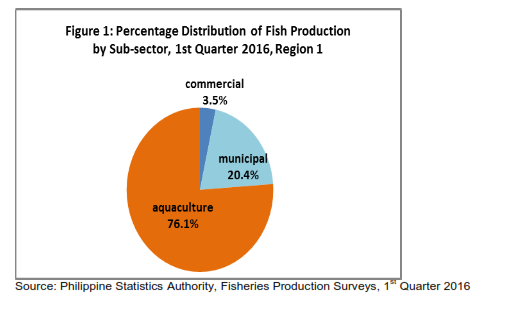
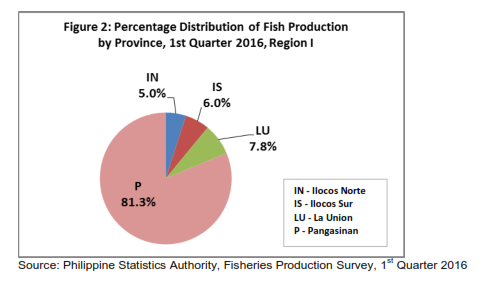
The province of La Union, which shared 7.8 percent to the total fish production of Region I, posted negative growth in production during the 1st quarter 2016. Its output in the 1st quarter 2016 was 2,351 metric tons, or 38.7 percent lower than the output in the same period last year. The municipal and aquaculture sub-sectors of the province registered lower growths.
The fish production of Ilocos Sur also registered lower production in 1st quarter 2016 of about 21.3 percent. Its production during the period was 1,820 metric tons, lower than the output of about 2,313 metric tons recorded in 1st quarter 2015. The commercial and municipal sub-sectors of the province posted decreases in output. Ilocos Sur contributed 6.0 percent to the total fishery production of Region 1.
The province of Ilocos Norte, which shared 5.0 percent to the total fish production in theregion, registered lower overall fish production in 1st quarter 2016 due to the decreasedoutput of its municipal fisheries sub-sector. Its total output of 1,505 metric tons was 8.3 percent lower than its output in 1st quarter 2015 of about 1,641 metric tons.
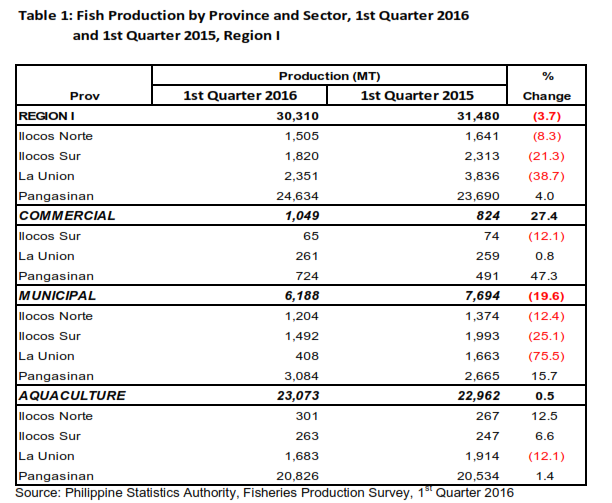
Commercial Fisheries
Commercial fisheries volume of production of Region 1 registered positive growth in the first quarter 2016. Production increased by 27.4 percent from its output in first quarter 2015 of 824 metric tons to 1,049 metric tons this year. This was contributed by the provinces of La Union and Pangasinan. The higher production was attributed to the presence of more school of fish, harvest of more payaos and artificial reefs, increased number of fishing days due to good weather condition, and bigger sizes of catch.
Meanwhile, volume of fish production of Ilocos Sur decreased by 12.1 percent from its output in first quarter 2015 of about 74 metric tons. Lesser payaos harvested, and lesser number of fishing operations due to long period of amihan were the factors that contributed to the negative growth in output.
In terms of provincial shares, Pangasinan accounted for 69.0 percent of the region’s commercial fish production, followed by La Union, 24.8 percent share, and Ilocos Sur, 6.2 percent share.
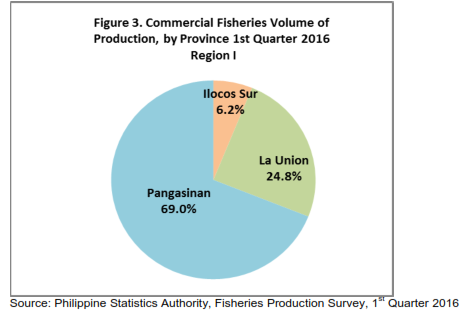
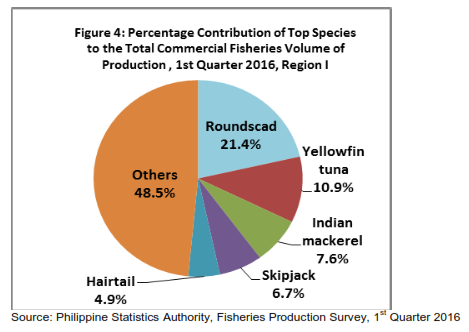

The province of Pangasinan contributed 50.5 percent of the region’s marine municipal fish catch for the first quarter 2016, followed by Ilocos Sur with 23.7 percent share, Ilocos Norte, 19.7 percent share, and La Union, 6.1 percent. Squid, Skipjack, Yellowfin tuna, Siganid, and Cavalla were the dominant catch in the region during the first quarter 2016.
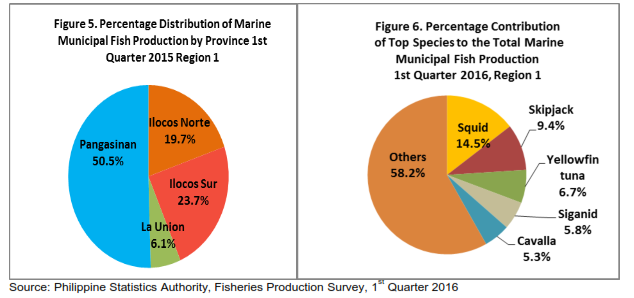

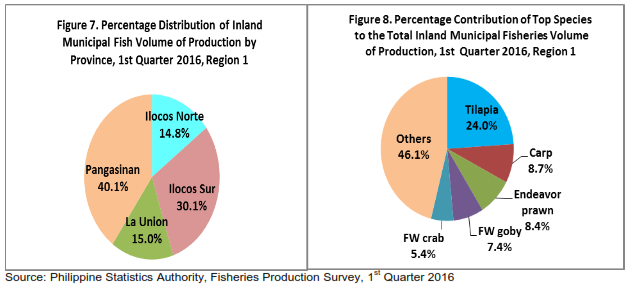
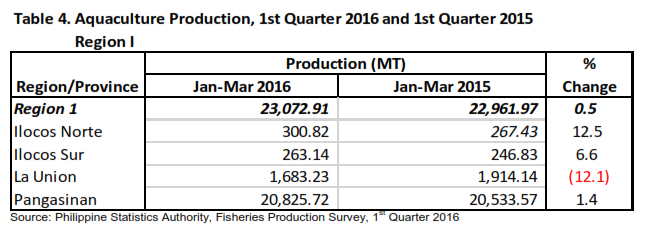
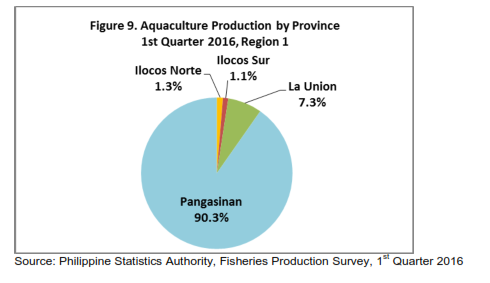
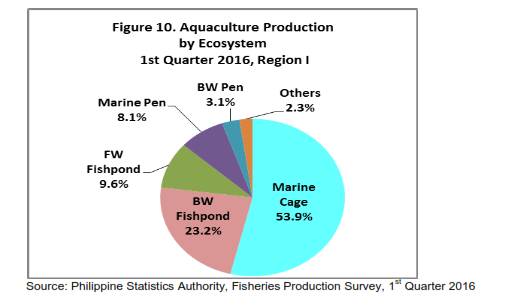
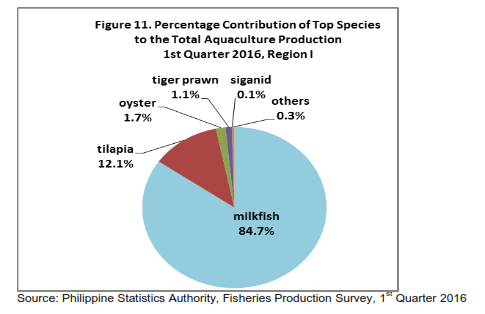
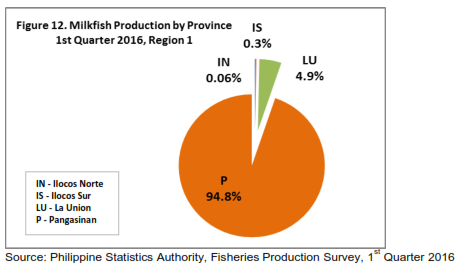
-
The Fisheries Production Survey of the Philippine Statistics Authority (PSA) is divided into four (4) major fisheries surveys. These are the Quarterly Commercial Fisheries Survey (QCFS), Quarterly Municipal Fisheries Survey (QMFS), Quarterly Inland Fisheries Survey (QIFS) and Quarterly Aquaculture Survey (QAqS). The commercial and municipal fisheries surveys aim to provide quarterly data on volume and value of fish production by species, by region and by province. The aquaculture surveys are intended to generate quarterly data on volume and value of cultured species by environment, by type of aquafarm, by region and by province.
-
The survey on commercial fisheries production covered 57 provinces and cities. For municipal fisheries and aquaculture surveys 81 provinces and cities were covered.
-
The sampling frames for the surveys of commercial and municipal fisheries were established in 2000 through a nationwide listing of landing centers (LCs). Updating of the lists was conducted over the years. The design used was a two stage stratified random sampling with the landing centers as the first-stage sampling units and the fishing boats as the second stage sampling units. The landing centers were stratified based on volume of fish unloaded. The province was the domain of the survey. Inland municipal fisheries included fishing in inland waters such as lakes, rivers, dams, marshes, swamps, etc. Household engaged in inland fishing was the unit of enumeration. For aquaculture survey, the lists of brackishwater fishponds, freshwater fishponds, freshwater fish pens/fish cages, marine fish pens/fish cages, oyster/mussel and seaweed farms by province served as the sampling frames. Updating of list frames for aquaculture was done simultaneously with the landing center during the previous years. With the support from the Bureau of Fisheries and Aquatic Resources (BFAR), Ilocos Region was able to conduct Aquaculture Farm Inventory (AqFI) in 2013. The aquafarms were stratified according to area. Simple random sampling was employed in the selection of sample aquafarms from each stratum.
-
Concepts and Definitions:Aquaculture – fishery operation involving all forms of raising and culturing of fish and other fishery species in marine, brackish and fresh water environment. Examples are fishponds, fish pens, fish cages, mussel, oyster, seaweed farms and hatcheries.Aquafarm – the farming facilities used in the culture or propagation of aquatic species including fish, mollusk, crustaceans and aquatic plants for purposes of rearing to enhance production.Brackishwater – mixture of seawater and freshwater with salinity that varies with the tide. Example are estuaries, mangroves and mouths of rivers where seawater enters during high tide.Commercial Fishing – the catching of fish with the use of fishing boats with a capacity of more than three (3) gross tons for trade, business or profit beyond subsistence or sports fishing.Fisheries – all activities relating to the act or business of fishing, culturing, preserving, processing, marketing, developing, conserving and managing aquatic resources and the fishery areas including the privilege to fish or take aquatic resources thereof (RA 8550).Fisheries Sector – the sector engaged in the production, growing, harvesting, processing, marketing, developing, conserving and managing of aquatic resources and fishing areas.Fish Cage – stationary or floating fish enclosure made of synthetic net wire/bamboo screen or other materials set in the form of inverted mosquito net (“hapa” type) with or without cover with all sides either tied to poles staked to the water bottom or with anchored floats for aquaculture purposes.Fishing Gear – any instrument or device and its accessories utilized in taking fish and other fishery species.Fishing Grounds – areas in any body of water where fish and other aquatic resources congregate and become target of capture.Fish Pen – an artificial enclosure constructed within a body of water for culturing fish and fishery/ aquatic resources made up of bamboo poles closely arranged in an enclosure with wooden materials, screen or nylon netting to prevent escape of fish.Fishpond – a body of water (artificial or natural) where fish and other aquatic products are cultured, raised or cultivated under controlled conditions. This is a land-based type of aquafarm. Note that the setting-up of fish cages in ponds does not make the operation of fish cage and at the same time a fishpond.Freshwater – water without salt or marine origin, such as generally found in lakes, rivers, canals, dams, reservoirs, paddy fields and swamps.Inland Municipal Fishing – the catching of fish, crustaceans, mollusks and all other aquatic animals and plants in inland water like lakes, rivers, dams, marshes, etc. using simple gears and fishing boats some of which are nonmotorized with a capacity of three (3) gross tons or less; or fishing not requiring the use of fishing boats.Landing Center – place where the fish catch and other aquatic products are unloaded and traded.Municipal Fishing – covers fishing operation carried out with or without the use of a boat weighing three (3) gross tons or less.

